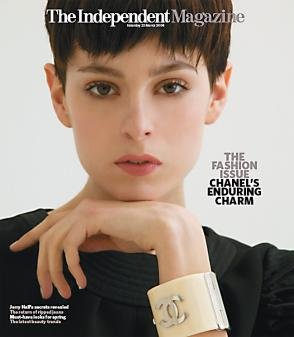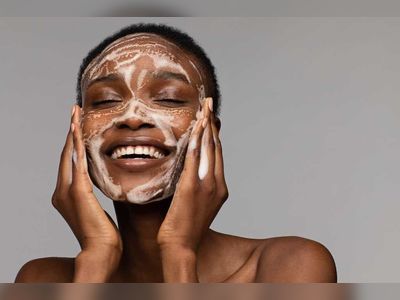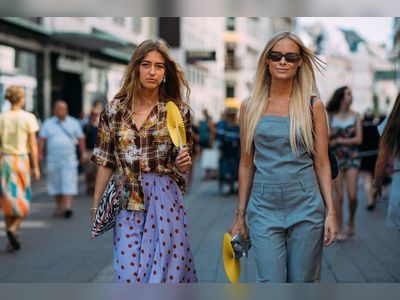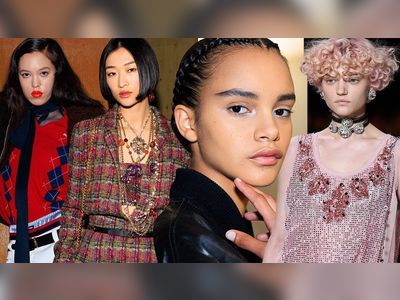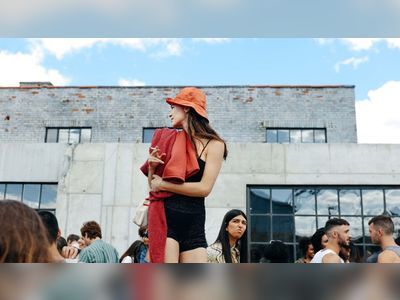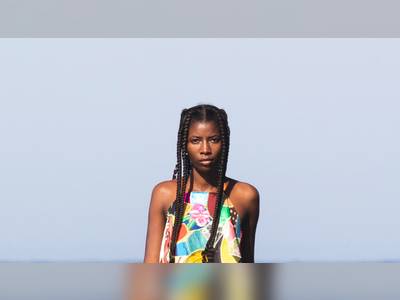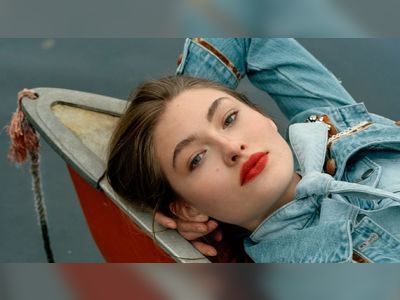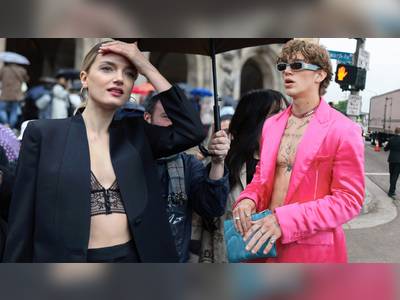Ask Karl Lagerfeld to sum up – in only 10 words – the power of Chanel and it's no great surprise when the great couturier, who, let's face it, is far from a shrinking violet where his dealings with the media are concerned, comes back with a rather longer answer than that.
Chanel encapsulates the idea of "modernity" first and foremost, he says. It embodies "a contemporary attitude – whatever the time or the decade". Chanel also stands for "luxury" and "the power of the logo". The iconic double C branding is surely the most instantly recognisable in fashion history. Also, for Chanel, read "the power of the handbag – the most famous in the world". Lagerfeld speaks here of the 2.55 in particular, named after its date of birth in February 1955, quilted, to keep its shape and echoing the texture of classic British outerwear, originally favoured by jockeys. (Chanel, for her part, favoured jockeys in return, but more of that later.) Suspended from a gilt shoulder strap, this was the first purse designed for a woman ensuring her hands were free.
The white camellia, too, says Lagerfeld, is an integral part of the story. It was Chanel's favourite flower and her successor has, in the past, coloured it every which way, on one particularly memorable occasion, even casting it in diamonds the size of boiled sweets as the single closure to a perfectly cut Chanel haute- couture jacket. "I also love camellias," Lagerfeld goes on to confirm, "and gardenias. But I love old-style-looking roses too, like the ones you can only find in Paris at Odorantes in Rue Madame." The black ribbon bow – today a staple of every couture catwalk and no longer just Chanel's own – is treated with similar diversity. "We do this in all kinds of shapes, colours and materials," Lagerfeld says.
Perhaps more significantly, the Chanel name stands also for "timelessness, but for fashion at the same time" – while the recipe may be updated each season in line with the mood of the moment, the main ingredients remain the same – and for "the two-tone shoe, not only the pump but also 'the ballerina' and so forth". Chanel gave this to the world in 1957 – the first pair had a sling-back – in beige with a black tip, which has the miraculous effect of foreshortening the foot and lengthening the leg. Then, continues Lagerfeld, there's "the magic address: 31 Rue Cambon". Chanel set up shop as a milliner in that very street in Paris for the first time in 1910. The plaque on the door originally read "Chanel Modes". Although it is now significantly expanded, it remains the company's headquarters to this day.
Lagerfeld goes on to cite "the mystery of the Coromandel screens she loved and which have inspired her": it is the stuff of fashion folklore that Chanel was always surrounded and indeed shielded by particularly fine examples of these. Finally, the world has Chanel to thank for "the mixing of real and fake jewellery and the invention of fashion costume jewellery", enjoying something of a resurgence just now, incidentally, as seen at the most recent round of international collections everywhere from Balenciaga to Lanvin and from Louis Vuitton to, well, Chanel. True to her unusually democratic stance, Chanel herself thought nothing of mixing diamonds and paste, real pearls with great ropes of more reasonably priced approximations. She wore them well and today Lagerfeld embellishes everything from sunglasses to handbags with more of the same.
"You see," Lagerfeld argues with an energy and enthusiasm that belie his 74 years, "here are already 12 reasons and you asked for 10... That shows the power – and the staying power – of Chanel. The image, the fashion and the idea of the woman herself as the first modern one. It is the idea of modernity, a life and a lifestyle that women can identify with."
It is now 25 years since Lagerfeld took to the helm of France's most famous fashion house. Chanel died in January 1971 and it seemed only decent that a good decade should go by before anyone dared to step into her perfectly formed, not to mention supremely influential shoes. While contemporary fashion is elsewhere characterised by an increasingly high-profile – and at times inept – game of designer musical chairs where the revival of potentially lucrative status labels is concerned, it is worth noting that Chanel has remained unswervingly faithful to Karl Lagerfeld – by now the greatest couturier still practising the craft – and Karl Lagerfeld has stayed true to Chanel – today fashion's best-known name. Upon hearing news of his contemporary Valentino's retirement announced in the autumn of last year, Lagerfeld said: "I am not very pleased because I think it is not good that he's stopping; he is in great shape. He should continue. It's no fun; he'll be bored."
Although Lagerfeld is the man at the helm of the Chanel brand today, it all began in the hands of the house's namesake, whose life story is as much a part of the label's many signatures as a gilt chain is to the hem of the jacket of a Chanel bouclé wool suit. If anyone might reasonably be described as an autobiographical designer it is Chanel, after all. Even the lining of the aforementioned 2.55 bag is coloured garnet – mimicking, by all accounts, that of the uniform she wore at the convent where she spent her early years.
Equally important is that Chanel's desire to create clothes sprang above all from her wish to dress herself in a manner she saw fit. She was nothing if not reactionary. "If I embarked on this profession it was precisely to make everything I didn't like unfashionable," she once said and she lived and worked by that rule tirelessly. Whichever way one chooses to look at it, the romance of this, perhaps the ultimate rags-to-riches tale, is unprecedented. With this in mind, it is small wonder that, almost 40 years after her death, not one but two Chanel movies begin filming this year: Audrey Tautou will play the young designer in Coco avant Chanel, directed by Anne Fontaine, and devoted to her young life; and Marina Hands (The Diving Bell and the Butterfly) is set to play the lead in Coco & Igor, directed by William Friedkin and telling the story of Chanel's relationship with the composer Stravinsky. Potentially less chic is a forthcoming TV mini-series starring Shirley MacLaine.
Gabrielle Chanel was born on 19 August 1883 in the French province of Saumur. Her father, Albert Chanel, was a market trader. Her mother, Jeanne Devolle, was of humble origins, bore several children and died young, in 1895, leaving her daughter to be educated by the nuns at an orphanage in Aubazine. Gabrielle was taught how to sew there and, when holidaying with her sisters, learnt the art of millinery – they loved hats. Aged 20 and based in the garrison town of Moulins, Chanel worked as an assistant in a shop specialising in trousseaux and layettes and then as a seamstress. By night she sang for her supper in cafés and bars and it was there that the slim, slight, dark-haired, black-eyed figure first became known as Coco.
In the early years of the 20th century, Coco Chanel moved in with Etienne Balsan, a famous horse breeder, and although not accepted by the elevated echelons of society in which he circulated, she became an accomplished horse woman and among the first of her sex to dare to wear jodhpurs. In order to deflect the received ideas of a mistress, dressed in the requisite frills and furbelows of the Belle Epoque style, Chanel set to adapting the staples of menswear to her needs, often scandalising others in her entourage by actually wearing men's clothing. "A woman is always over-dressed and never sufficiently elegant," she said later and few did more to correct that fact than Chanel. Her uniform of strictly tailored, unembellished garments topped with nothing more frothy than a straw boater caught on and it wasn't long before she was making hats, in particular, for her friends.
In her mid-twenties, Chanel was befriended by an English industrialist, the renowned polo player Arthur "Boy" Capel, who duly installed her in an apartment in Paris where she became his lover and began making hats on a more professional basis. By 1910, interest in her minimal and profoundly modern designs was such that she had outgrown this space and opened a shop at Rue Cambon, naming it Chanel Modes. It wasn't long before she had expanded her operation to include a store in Deauville selling clothes as well as hats, and then a fully fledged couture house in Biarritz where, by 1916, she was responsible for 300 employees all dedicated to the task of creating naturally feminine and relatively simple clothing, favouring freedom of movement and rejecting anything even remotely ostentatious or superfluous.
Across the Atlantic – and the American market was as important then as it is today – US Harper's Bazaar picked up on her success, publishing a picture of what they described as "the charming chemise dress", again borrowed from menswear – this time, specifically, a man's shirt. A year later, Chanel cut her lustrous dark hair into a neat bob, the better to suit her naturally androgynous silhouette and sun-tanned skin. Although it is often said that she invented the swimsuit – and it's certainly true that she went on to craft stretch clothing in jersey, formerly the preserve of nothing more haute than men's underwear – here Lagerfeld begs to differ.
"There are no images of Chanel in swimsuits and we know only the heavy bathing-suit costumes she designed for the Ballets Russes' Le Train Bleu," he says. Jean Cocteau also worked on the 1924 production and the collaboration between the fashion designer and the artist, who later also introduced her to Picasso, was to continue for more than 10 years. "But Chanel embodies the idea of the modern women and so she inherited that image too. People think she was the first. In fact she was not, but she is remembered that way. Now sportswear is all over the world and is not only worn for sport. Some sportswear and some sports did not exist in Chanel's time, but they represent something she would have liked if she had known it."
In 1919, Capel, described by Chanel as "the love of her life", was killed in a car crash and she threw herself into her work creating many of the looks that remain the staple of the contemporary woman's wardrobe to this day. In 1926 she designed her first "little black dress", described by Vogue as the fashion equivalent of the Ford motorcar; in 1928 she came up with her first tweed suit. That is not to say that her personal life was anything but colourful. Over the years she was linked to the exiled Russian Grand Duke, Dimitri Pavlovich, related to Tsar Nicholas II, who introduced her to Ernest Beaux (the perfumier with whom she created Chanel No 5) and to the sparkling beauty of baroque jewellery. She was also the lover of the second Duke of Westminster, Hugh "Bendor" Grosvenor, who shared her life for 10 years, demonstrating the potential power of great wealth – he was widely considered the richest man in Europe at that time – and whose aristocratic English wardrobe inspired her work continuously. "Westminster is elegance itself," she once said. "He never has anything new – I had to go out and buy him some shoes. He has been wearing the same jacket for 25 years." Despite the longevity of their relationship, Chanel refused to marry the Duke. "There have been several Duchesses of Westminster," she would say. "There is only one Chanel."
By 1935, Chanel owned five buildings in Rue Cambon, employed 4,000 people and was at the height of her power. In 1939, however, and just before the outbreak of war, she closed her couture house, stating: "I thought there wouldn't be any more dresses." She would, of course, have been able to live out the rest of her days in splendour, profiting from the sale of accessories and fragrance alone. Throughout the Occupation, Chanel spent most of her time at the Paris Ritz where she conducted an affair with a Nazi officer. At the end of the war she was arrested – though not charged – for collaboration and spent the following years in relative obscurity based in Switzerland. And that could have been that.
Some things are not to be, however, and in 1954, at the grand old age of 71 and spurred on at least in part by her rancour at the immense success of Christian Dior's proudly people-pleasing and retrogressive New Look, she began designing couture collections once more. Dior, she said, was "a madman" for wanting to put women back into corsets and overblown skirts. There was nothing for it but to show the world once again how it might be done.
While the French – by then in the thrall of not only Dior but also Cristobal Balenciaga, Pierre Balmain and Jacques Fath – were less than effusive over Chanel's new designs, emancipated American women were more quick on the uptake, viewing her softly tailored jackets, silk blouses and wrap-over skirts as more fitting for women in the latter part of the 20th century than anything her competitors had to offer. It wasn't long before what was described as "The Chanel Look" was restored to its former glory. It upholds its position as purveyor of all that is quintessentially understated and chic to this day.
"I don't remember the first time I saw the Chanel logo," says Lagerfeld – in its original form, the double C was the fastening on the 2.55 bag. "But I noticed it when I took over Chanel, when real logo power started all over the world. For a company it is very important today because, much more than in the past, we all sell in parts of the world where they cannot read our writing or understand our languages. In one part – a very big part – of the world it is all about signs when they write. They can memorise perhaps the famous "CC" but they have difficulties reading the name first. They find out later. In the past we sold mostly to people who knew our culture and could read English or French. Now it is only a part of our clientele. Logos are the Esperanto of marketing, luxury and business today."
And there is perhaps no more potent signifier of luxury than the name of Chanel – from the logo itself to the cosmetic and fragrance lines, accessories and, of course, clothing. Lagerfeld says that these – and he is speaking of the Chanel jacket in particular – have "a staying-power that is difficult to explain".
The secrets of its success are manifold but inextricably linked to the life, times and pioneering spirit of the late Coco Chanel herself. "Many of Chanel's private dicta have entered into the unspoken rules that still govern fashion," wrote Cecil Beaton in The Glass of Fashion, published in 1954. "Though Chanel herself echoed the theory that fashions are never revived, it is a tribute to her rare and remarkable practicality, and an anomaly in the annals of recorded fashion, that few of her innovations became dated."
More than 50 years on, his words continue to resonate, and of that, Gabrielle "Coco" Chanel herself would be proud.
